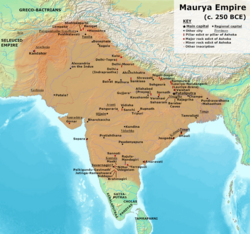مائوریا
| مائوریا امپراتوری | ||||
| ||||
 مائوریان | ||||
| پایتخت | پاتالیپوترا (اسا بیّه پاتنا) | |||
| زبان(ها) | باستانی هندی (شامل مغدی پراکریت, پراکریت) | |||
| مذهب | هندوییسم(براهمانیسم) بودیسم جاینیسم آجیویکا | |||
| دولت | سلطنت | |||
| امپراتور | ||||
| - 322–298 BCE | چاندراگوپتا | |||
| - 298–272 BCE | بیندوسارا | |||
| - 268–232 BCE | آشوکا | |||
| - 232–224 BCE | داشاراتها | |||
| - 224–215 BCE | سامپراتی | |||
| - 215–202 BCE | شالیشوکا | |||
| دوره تاریخی | Antiquity | |||
| - تأسیس | 322 BCE | |||
| - انقراض | 185 BCE | |||
| مساحت | ۵٬۲۰۰٬۰۰۰کیلومترمربع (۲٬۰۰۷٬۷۳۱مایلمربع) | |||
| پیل یکا | پانا | |||
| امروزه بخشی از | ||||
Peter Turchin Thomas D. Hall and Jonathan M. Adams (2006). "East-West Orientation of Historical Empires" (PDF). 12 (2). Journal of World-Systems Research: 219–229. {{cite journal}}: Cite journal requires |journal= (help)
| ||||
مائوریا، مائوریان یا موریا اتا هندی امپراتوری بییه که آهن گدر وجود داشته و ونه سامون خله بییه و میون سالهای 322-185 پیش از میلاد حکومت کارده.[۱][۲]
این امپراتوری ره سال 322 پیش از میلاد چاندراگوپتا بساته. وه ناندا امپراتوری ره رِقِد بدا و شه غربی سامونها ره گسترش هدائه. وه اسکندر ِسربازون ره جنگ دله شکست هدائه و ونه جانشینهایِ سامون ره پئی هدائه.[۳]
این امپراتوری خله گت بییه. شه گتترین سامون گدر، شمال جه هیمالیا، شرق جه آسام، غرب جه بلوچستون و هندوکش کوه ره وَر خارده.[۴] وشون جنوبی سامون هم به سمت جنوب تدریجاً ویشته بییه.[۵][۶]
چاندراگوپتا و ونه جانشینان شه سامونِ تجارت، کشاورزی و اقتصاد ره بتتر هاکردنه و اتا سیستم واحد مالی، مدیریت، و امنیت مسائل وسّه بساتنه که خار بییه. آشوکا امپراتوری بییه که مائوریا ره به اوج خادش برسنییه و جنوبی سامونها ره فتح هاکرده په، تا نیم قرن کشور ره امنیت کامل جه اداره کارده و علوم و دانش سَره زحمت بکشییه. آشوکا بودایی بیّه و گاته ونه صلح و آرامش همهگیر بوائه و این دین ره تنک کارده. وه مبلغونی به سریلانکا، آسیایِ جنوب شرقی، آسیایِ غرب[۷] و حتی مدیترانه و اروپا برسنییه.[۳]
امپراتوری جمعیت حدود 50-60 میلیون نفر تخمینبَزه وانه که پرجمعیت ترین امپراتوری باستانی وانه.[۸][۹] هندِ رسمی نشون اسا سرستونی هسته آشوکایِ امپراتوری گِدِر بساته بیّه.
پانویس
[دچیین]- ↑ Kulke, Hermann; Rothermund, Dietmar (2004). A History of India. 4th edition. Routledge, Pp. xii, 448. ISBN 0-415-32920-5.
- ↑ Thapar, Romila (1990). A History of India, Volume 1. New Delhi and London: Penguin Books. Pp. 384. ISBN 0-14-013835-8.
- ↑ ۳٫۰ ۳٫۱ Rajadhyaksha, Abhijit (2009-08-02). "The Mauryas: Chandragupta". Historyfiles.co.uk. Retrieved 2012-03-01.
- ↑ The account of Strabo indicates that the western-most territory of the empire extended from the southeastern Hindu Kush, through the region of Kandahar, to coastal Balochistan to the south of that (Raychaudhuri & Mukherjee 1996, p. 594).
- ↑ Sri Lanka and the southernmost parts of India (modern Tamil Nadu and Kerala) remained independent, despite the diplomacy and cultural influence of their larger neighbor to the north (Schwartzberg 1992, p. 18; Kulke & Rothermund 2004, p. 68).
- ↑ The empire was once thought to have directly controlled most of the Indian subcontinent excepting the far south, but its core regions are now thought to have been separated by large tribal regions (especially in the Deccan peninsula) that were relatively autonomous. (Kulke & Rothermund 2004, p. 68-71, as well as Stein 1998, p. 74). "The major part of the Deccan was ruled by [Mauryan administration]. But in the belt of land on either side of the Nerbudda, the Godavari and the upper Mahanadi there were, in all probability, certain areas that were technically outside the limits of the empire proper. Ashoka evidently draws a distinction between the forests and the inhabiting tribes which are in the dominions (vijita) and peoples on the border (anta avijita) for whose benefit some of the special edicts were issued. Certain vassal tribes are specifically mentioned." (Raychaudhuri & Mukherjee pp. 275–6)
- ↑ "Buddhism in Iran, Mehrak Golestan". iranian.com. 2004-12-15. Retrieved 2014-07-25.
- ↑ Boesche, Roger (2003-03-01). The First Great Political Realist: Kautilya and His Arthashastra. p. 11. ISBN 9780739106075.
- ↑ Demeny, Paul George; McNicoll, Geoffrey (May 2003). Encyclopedia of population. ISBN 9780028656793.
